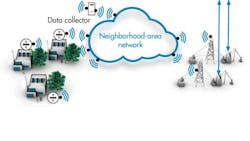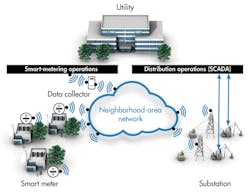Smart Grid Neighborhood-Area Network Standard Charges Ahead
The ZigBee Alliance and a group of leading smart-metering and Smart Grid member companies are developing a communication profile aimed at achieving true plug-and-play interoperability between the members’ wireless Smart Grid neighborhood-area network (NAN) products and solutions. The NAN is defined as a utility’s last-mile, outdoor access network that connects smart meters and distribution automation devices to wide-area network (WAN) gateways such as RF collectors or data concentrators and field devices.
The ZigBee wireless technology based on the IEEE's popular 802.15.4 standard is widely used in home-area networks (HANs) to connect smart meters to home monitoring and control consoles. Up to now there has been no one standard for connecting the smart meter back to the utility. Multiple wireless and wired technologies have been used. Now this effort may result in a ZigBee standard that can be widely adopted (see the figure).
There is a global requirement from regulators and utilities for a standards-based interoperable NAN. Open global standards give utilities a wider choice of product features, increased price competition, reduced supply risk, and flexibility in selecting vendors, all while ensuring that products will interoperate seamlessly. Existing IEEE and IETF standards on their own do not ensure interoperability due to the many options available within the standards. The NAN specification will fill the gap by selecting the most appropriate options between standards and defining a communications profile with certifiable interoperability. This will be a significant improvement for utilities compared to the non-interoperable, proprietary single-vendor solutions available today.
To ensure interoperability, a full wireless communications protocol is being defined for Layers 1 through 4 of the ISO OSI communication stack, which provides a harmonized transport network supporting different IP-based (Internet protocol) applications. Layers 1 and 2 will be based on the IEEE 802.15.4g amendment to the IEEE 802.15.4 (2011) standard that was introduced to enable the development of interoperable NANs. Layers 3 and 4 will be based on IEFT standards including the IPv6 network layer and associated networking schemes, appropriate routing and transport protocols (e.g., RPL, UDP, and TCP), and relevant security mechanisms.
This wireless communications profile will enable interoperability between different vendors that have all implemented their smart meters, Smart Grid devices, and communication infrastructure node products according to the certifiable NAN communications profile. Today’s existing Smart Grid applications such as smart metering and distribution automation will run on top of this interoperable wireless IPv6 communications profile.
This NAN standardization work will establish a test and certification program supported by independent test houses to certify the interoperability of different manufacturers’ Smart Grid products and solutions. The ZigBee Alliance will maintain a register of certified smart-meter and Smart Grid products to provide confidence for utility customers when selecting a Smart Grid vendor. The ZigBee Alliance already has a great deal of experience in successfully managing test and certification programs for other application areas such as smart energy.
To date, the definition and documentation of the market requirements and the detailed technical requirements for the NAN have been completed. “Proof of concept” events to test the interoperability of the physical layer and media access controller (PHY/MAC) functions that will be included in the NAN standard have been held during the past year involving companies from around the world. All participants’ NAN products were able to communicate with each other through the PHY and MAC layers. In addition, several companies demonstrated interoperability for basic IP functions. The NAN standardization work is anticipated to be completed by the end of 2014. It also will include the Technical Specification, Protocol Implementation Conformance Statement (PICS), and Certification Test Plan.
About the Author

Lou Frenzel
Technical Contributing Editor
Lou Frenzel is a Contributing Technology Editor for Electronic Design Magazine where he writes articles and the blog Communique and other online material on the wireless, networking, and communications sectors. Lou interviews executives and engineers, attends conferences, and researches multiple areas. Lou has been writing in some capacity for ED since 2000.
Lou has 25+ years experience in the electronics industry as an engineer and manager. He has held VP level positions with Heathkit, McGraw Hill, and has 9 years of college teaching experience. Lou holds a bachelor’s degree from the University of Houston and a master’s degree from the University of Maryland. He is author of 28 books on computer and electronic subjects and lives in Bulverde, TX with his wife Joan. His website is www.loufrenzel.com.

